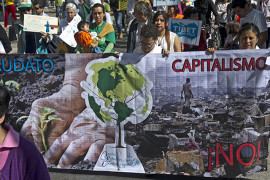
Finally, it has now been established that ‘climate change’ is as real as it gets.
With experts painting a bleak picture of the planet’s future in 2050, it is imperative to get buy-in of global policymakers as grassroots actions by individuals and initiatives by community groups alone would not suffice.
The Big Three in CO2 emissions
Kyoto Protocol failed to yield any meaningful results because the US never ratified it and the world’s two biggest polluters, China and India, were exempt from the treaty.
Security fears risk overshadowing Paris climate summit
Now, world leaders meeting in Paris, however, have very different agendas in mind.
Representatives of developing nations strongly believe that the west has no right to impede their economic growth in the name of ‘climate politics.’
Categorically speaking, during Paris talks, Indian PM Modi has demanded an exception in CO2 quotas despite a carbon footprint growth trajectory which is all set to exceed that of China and EU, and a population growth rate that adds one Australia to the world population every year.
While India has shown little interest to leapfrog lest the west promises billions of cash inflows for green investments, Obama, on the other hand, sees Paris as a chance to create his legacy.
But it was also Obama and his administration who forced India in 2013 to end domestic subsidies on solar panels under WTO regulations - despite the fact that one-fourth of India had no electricity. Ironically, US government grants annual subsidies amounting to $40 billion for renewable sources including solar energy.
Paris talks
Twelve days, 147 world leaders and 30,000 diplomats - the UN conference to reduce greenhouse gas emissions has a carbon footprint of over 300,000 tonnes. Keeping in view these facts, Paris talks appears to be a slick marketing campaign.
‘Climate change’ is the new buzz word that will neither save the planet nor promote investments in research and development.
Moreover, the carbon accounting is not very clear - should we associate the carbon footprint of the manufacturing process with the end consumer or the producer? Carbon emissions due to production of iPhones in China and then sold in North America must be attributed to US and not China. Otherwise, this practice encourages the trend of decreasing footprint by outsourcing polluting industries to developing countries besides benefiting from cheap labour economics.
Six years ago, China had a stance similar to that of India now, and was unwilling to commit to any hard targets. Now China believes that the conference might mark the start of a new energy revolution and does not wants to miss the wave. It desires to dominate the renewable industry through super economies of scale - making a viable global economic case for green energy sources.
Way forward
Any deal, however, would be very important for the world.
There is still hope that a new pact could be negotiated for reducing greenhouse gas emissions.
The key to success is not only to convince China and India that there is a low-carbon trajectory for sustained economic growth, but US rather needs to lead by example. A sizeable majority of US Congress and the Government of Pakistan (GoP) leaders still deny climate change which could be a big hurdle in getting any international treaty ratified as it was the case with Kyoto Protocol.
Undeterred by Climate Summit, Pakistan embraces coal
Are Paris talks an exercise in negotiation? And is any deal, if reached, a zero-sum game?
Yes and no.
Cutting emissions may not necessarily mean a decline in growth but we have to yet see a working model of a low-carbon economy.
Although President Obama is politically correct to observe that the US “recognises its role in creating this problem,” but he has to be blue in the face to reach consensus.
The writer is a Cambridge graduate and is working as a management consultant
Published in The Express Tribune, December 7th, 2015.
Like Business on Facebook, follow @TribuneBiz on Twitter to stay informed and join in the conversation.

















1714119118-0/image-(7)1714119118-0-270x192.webp)















1714024018-0/ModiLara-(1)1714024018-0-270x192.webp)









COMMENTS (5)
Comments are moderated and generally will be posted if they are on-topic and not abusive.
For more information, please see our Comments FAQ